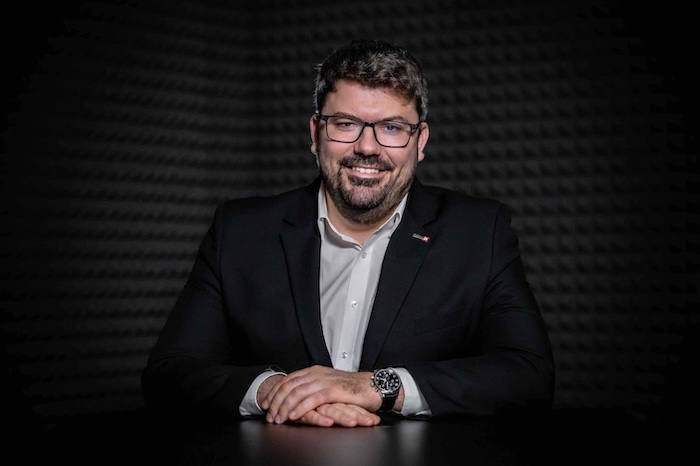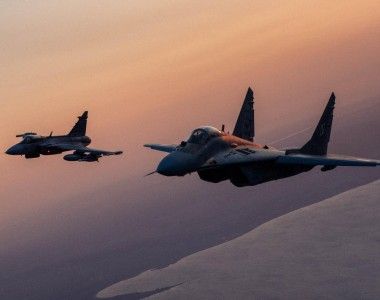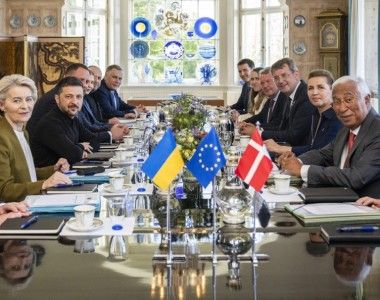Light Helicopter for the Polish Armed Forces. Airbus Reveals the Details [INTERVIEW]

Photo. Defence24.pl
In our range of products, as you know, there’s H145M, which is like a Swiss army knife. It can perform so many different missions. It is one single platform where you can change the configuration rapidly. (…) And thanks to Spike ER2 and integration, H145M gives you the flexibility to have a strongly armed, light twin-engine helicopter to solve some tasks on the battlefield.
Jędrzej Graf: Poland has recently announced that a combat-training helicopter is the first priority regarding the helicopter fleet. What is the offer of Airbus and how does it fit the requirements of Poland?
Airbus Helicopters Executive Vice President Olivier Michalon: Well, we see more and more that value for money, versatility, multi-mission capability are the main criteria for many customers. And in our range of products, as you know, there’s H145M, which is like a Swiss army knife. It can perform so many different missions. It is one single platform where you can change the configuration rapidly.
We are convinced this is the best value for money. And this is also our customers« prospect saying it because we have record sales for the H145M. We will continue to be successful with this aircraft and we are confident of what we can deliver. This is a question of commitment from the manufacturer to the operators.
And we know that for this mission, which is training, light attack, but also any other mission the helicopter can complete, H145M is the best option in our product range. So this will be our offering.
Poland acquired a large fleet of Apache, but now the country does not have a modern training platform, and the Polish schedule of Apache deliveries is very ambitious. What kind of delivery schedule can you offer Poland, how ambitious could it be?
Our primary objective is to clearly understand the requirement and how much we may be able to fit to the ambitious schedule as the H145 is in high demand. And if there is a gap, we have solutions, we can organize anticipated training with the forces that currently operate H145M. It may be Military Flight Training School in the United Kingdom with the support of Babcock, where by the way future Apache pilots of the British Army are being trained, there is also possibility to organize training in Germany. So we can organise training quite easily.
And in the US, Apache pilots are being trained on the Lakota helicopter, which is the US Army’s version of H145. So regarding any potential gap in delivery schedules, we are confident that we will be able to find a solution.

There are several criteria coming to the equation. When do you receive the Apache, how long does it take to manufacture the H145M and what would be the gap. And this is where the intimate relationship we have with our customers, as well as the willingness to develop government-to-government relationship between them and Poland will enable to find solutions.
But is it possible to some of the „gap-filler” period training take place in Poland, or will it be outside Poland, like Germany or the UK?
First and foremost, we need to understand that either UK or Germany would be gap filler only, and the objective training would take place in Poland unless Poland decided to outsource its helicopter training, which would be a different story. And I am convinced that Poland would like to have an autonomous training capability.
And we think it is the right decision, so we would support Poland to have its autonomous training capability. We know Poland already has a training school and we would help you to take it to the next level, to train the next generation of the young cadets. We would also help existing pilots to transition from the helicopters they are flying today to Apache or any other platform that Poland is acquiring.
We also need to remember that building autonomous training capability is always taking time, because you need not only to deliver helicopters, but also to train instructors and develop infrastructure. So Poland has a chance to become one of the master training centers for the military helicopters as an objective solution, at the same time in transition period you may have to use some existing capacity in the transition period in other countries, like UK. Because a time is needed to build the comprehensive training capability, it is much more than the delivery of the helicopters themselves.
Polish military has expressed some interest in the training light platform taking also the combat support role as well as some responsibility in tasks for special operation forces. Could you a little bit elaborate of H145M capacity in this?
So let’s start with the special forces. Germany has been operating and will continue to use the H145, both H145 civilian version and H145M – the military version to deploy the special operations forces teams wherever they need it. The aircraft, the way it is designed and organized, whether it is in an urban environment or a wider theater of operation.
When it was designed, it was also built with purpose of this mission. It is not a civilian solution that was later adapted to some military tasks, it was part of the design. And all upgrades did take this type of operation into account, because special operations require quite big loading capacity, and the power of H145/H145M brings all the safety needed to such a mission.

Photo. Maciej Szopa/Defence24
And second, with regard to the armed support role, Cyprus, which already has received its first helicopters, has asked us to develop a version equipped with the Spike ER2 missile. This version will become a benchmark and we are in discussions with several customers in Europe and outside Europe, because it is high value for money and high capability, and Spike missiles are also used broadly in Europe and elsewhere.
Of course H145M is not the same category as Apache. However, you don’t need the Apache to do all the missions, some of them can be performed by smaller helicopters. And thanks to Spike ER2 and integration, H145M gives you the flexibility to have a strongly armed, light twin-engine helicopter to solve some tasks on the battlefield. So it is a very good complement to Apache. And if you train your pilots on H145M, you can fly combat support and special operations support missions on the same platform, it is a big benefit in support of transition.
I would like also to ask about potential industrial benefits of this cooperation. As you know, we have Sikorsky/Lockheed Martin and Leonardo facilities here in Poland, as well as state-owned companies from PGZ Group. So how could a Polish H145M purchase benefit the industrial cooperation?
I will answer along two different paths. First of all, Airbus Helicopters is are in Poland. We are in Łódź with 150 highly-skiled engineers, who are directly involved in the development of the product lines. Existing products but also new prototypes, which will define the future of helicopters. The entire Airbus Group in Poland is 800 employees, in Łódź, but also Gdańsk and Warszawa-Okęcie. So this matters, it brings a lot value. That is the first thing.
Secondly, cooperation is a part of our DNA. This is how we became a global player, by cooperating when and where it matters, and where it was mutually beneficial. This is what created the success story that Airbus Helicopter is. So yes, we are open to cooperation, it depends on whether it makes sense from volume standpoint, it has to be a rational decision from business point of view. 10 years ago we were ready to build a full assembly line of Caracal, not only a final assembly line, we would have created 1250 direct jobs for Poland over the lifespan of a helicopter programme. We demonstrated that we could do it and we were willing to do it.
The decision was what it was, so the industrial project was cancelled, and part of the industrial project was actually transferred to Hungary. It was a great project and a missed opportunity, as we said Poland could already have had 50 operational Caracals in their fleet and already be exporting Caracals from Poland. But that is the past, so let us turn a page and move to the future, write a new chapter. Going back to H145M, we are offering you a highly capable and very interoperable platform. We are going to provide you with a sovereign capability not only regarding training but also sustainment – not only for Poland, but also for other countries. And I highlight that PGZ Group would be a partner, so we are speaking of a fully sovereign capability, not owned by a third party.
Read more
US Army has been using a variant of H145M, UH-72A Lakota, to train its pilots, but recently they announced that they want to change the system, as they are not fully satisfied with the training solution they have. How do you comment on that, what is the background of this story?
First of all, it is not the helicopter itself that is not considered a right solution. It has been the right solution since 2006. As you may have read, the US government has decided to go for a massive cost cutting campaign, including reducing the cost of pilot training. They consider that for pilots that will fly on Apache, Chinook or Black Hawk you still need light two-engine helicopter for training.
At the same time, as we understand it, they consider that for the initial pilot training, a single-engine helicopter would be a more economical solution. This is the motivation: cost cutting and perhaps some changes in the initial training. And by the way, Lakotas that will not be flying training for Active Army will probably be transferred to National Guard or other another governmental operator.
So the Lakota, whether it is the legacy version, UH-72A, or the new one, UH-72B, will continue to fly in the United States. The reason for this adjustment of the fleet is the cost cutting. They are satisfied with the helicopter, the safety record is very good, it’s just that they are planning to make some reductions in costs in initial training. But I believe that this decision will not affect the credibility of the H145/H145M platform as a whole. Many countries including the UK and Germany use twin engine helicopters, such as H135 which you know from the Air Ambulance Service and also H145 from basic training onwards. I also know that Poland has already bought some modern very light helicopters for basic training and now wants to procure a twin engine system.
In Poland there was also a discussion on the Apache force structure changes, which were made by the same administration that is reducing Lakota due to operational costs.
What I can tell you is that having not sufficiently trained pilot who is flying with risks of incidents and/or accidents with the Apache is expensive. The pilots need to be trained very well. What US is doing is a broad cost-cuttiing effort across the whole administration, both military and civilian. I also would like to say Secretary Pete Hegseth supports the Lakota and decided to direct it to the border mission, he repeatedly said that he is satisfied with the helicopter itself.
We also need to remember that US government, in particular the US Marines, have started an Aerial Logistic Connector, a project for Class 4 UAV which is to be able to carry up to a ton of payload, fully autonomous. In practice this means that the US may use more autonomous platforms as opposed to manned helicopters in the future. But paradoxically in Aerial Logistic Connector project, autonomous platforms similar to conventional helicopter designs are being sought. We are part of this competition, with modified H145M. The competition is in its finals, we are taking part with H145M, and the decision will be made in the near future, possibly by the end of the year.
Let us move beside H145M a bit. Like the Head of General Staff recently said, Poland is also seeking other types of helicopters, including the heavy transport helicopters, where Chinook is a likely contender but also naval multi-role helicopters. What would be the offer of Airbus Helicopters here?
To start with, we are open to discuss any requirement with the Polish government, we are ready to expand cooperation beyond H145M. Regarding the heavy helicopters, like Chinook, we do not produce such helicopters and focus on medium multi-role such as Caracal and NH90.
For the Naval helicopters, NH90, which is being made by Airbus Helicopters and Leonardo together, is becoming a benchmark. The design is now mature and also very capable, it is cooperating with many NATO frigates.
I would also like to say that from the talks of Armament Agency it seems that Poland long term may need up to 60 helicopters to replace W-3 Sokol. H145M could be a solution to some wider requirements than the advanced training and light combat, name it special operations, disaster response and others. Let us start with the combat-training, and perhaps we will move in this journey further. We are open to that.
Thank you for the conversation.




